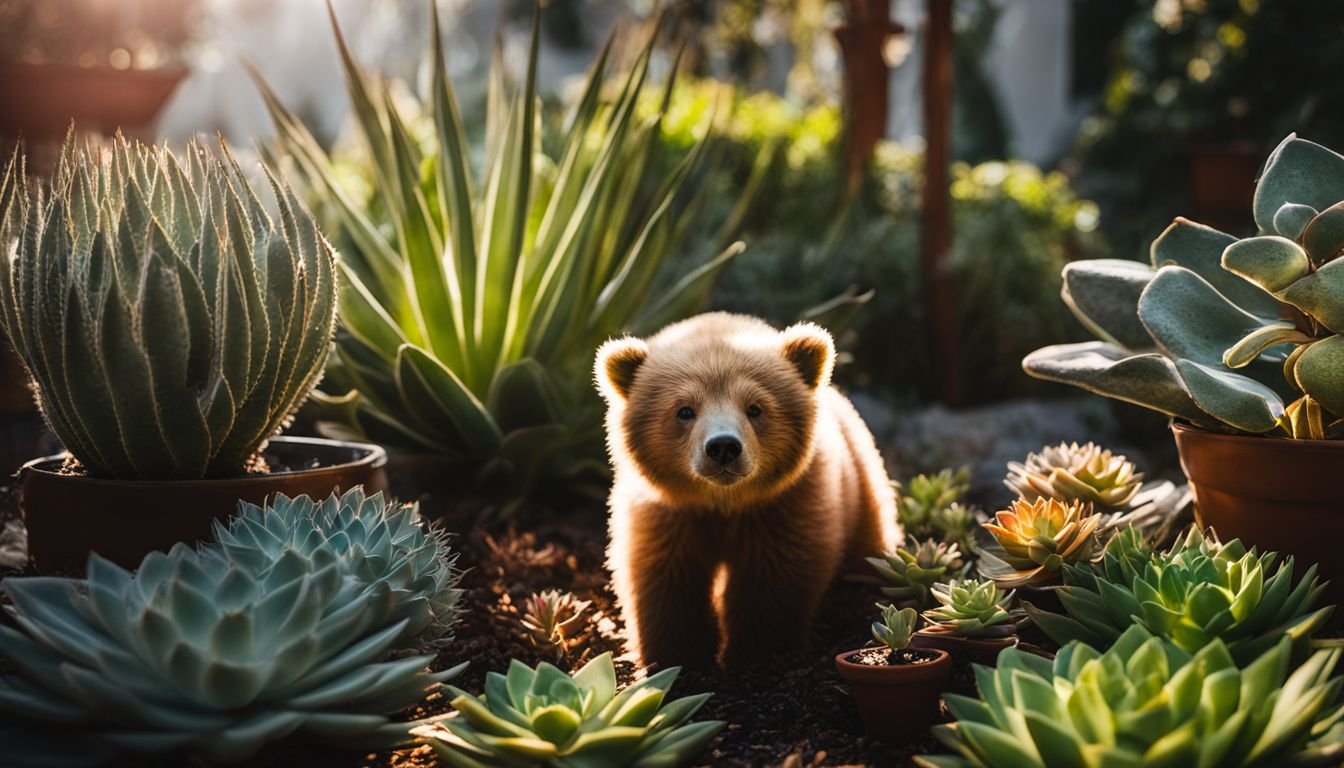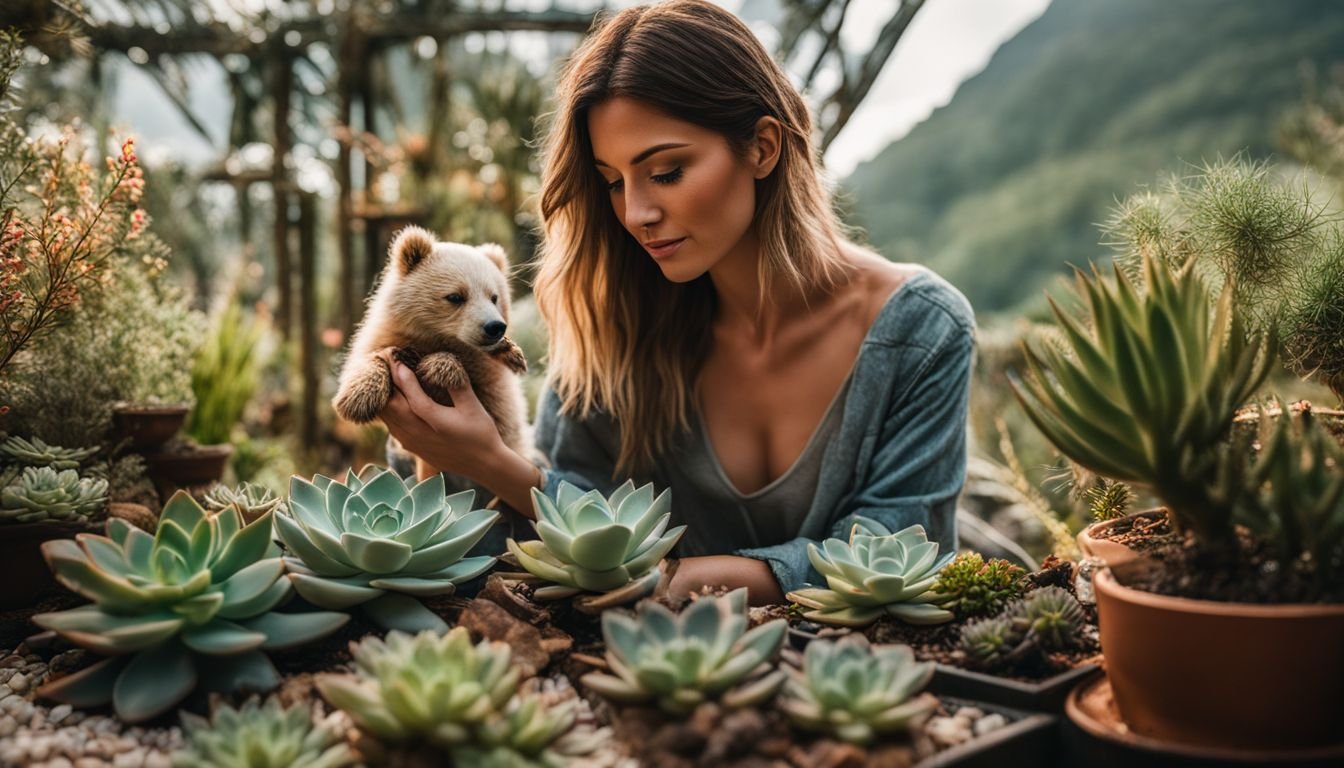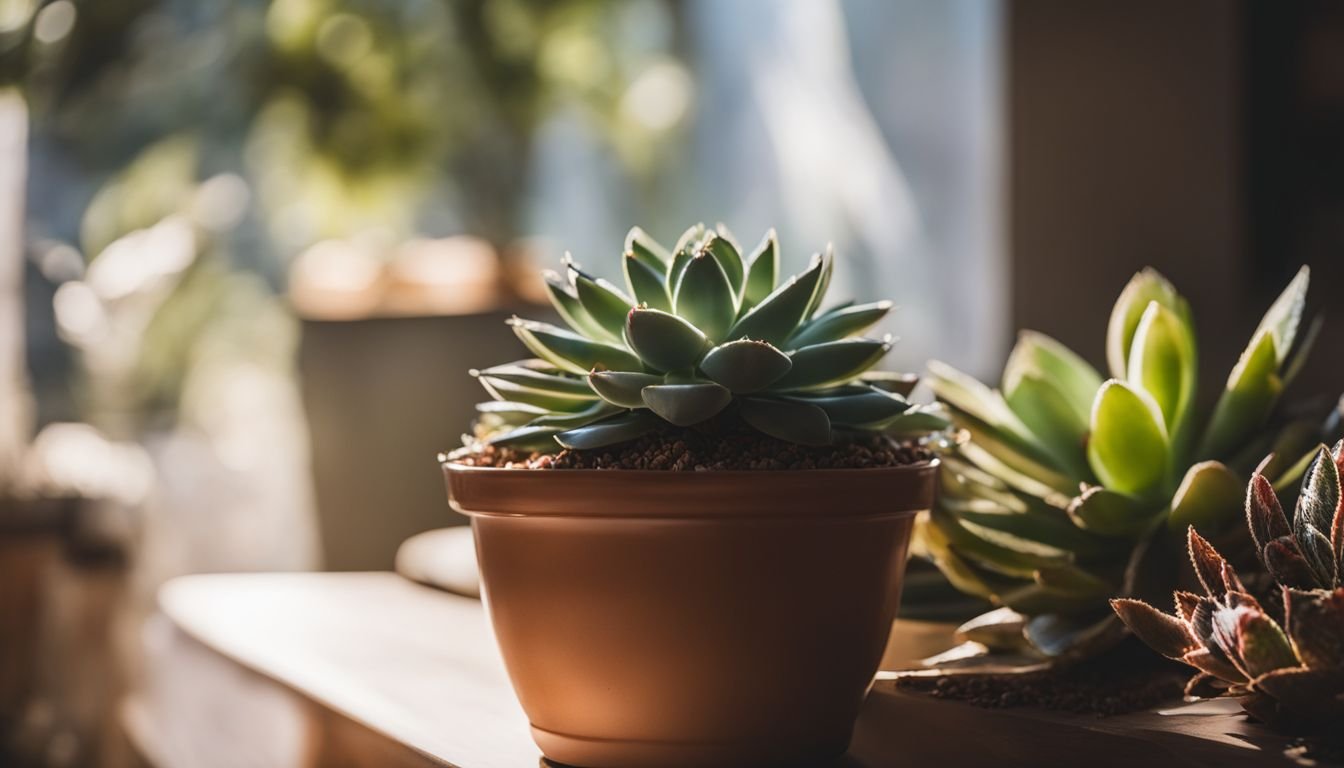Ever had a crack at nurturing an extraordinary plant indoors but it turned out to be a bit of a mission? You’re certainly not on your own, mate. Plenty of us here have been in the same boat, particularly with unique beauties like the Bear’s Paw succulent.
We all adore its fuzzy leaves that nicked their look from bear claws and those cheerful orange bell flowers it pops out in spring when it’s feeling chipper. So, we’ve hit the books and come up with some top-notch advice to help you care for these delightful plants.
In our yarn, we’ll guide you through everything from picking the perfect spot in your pad for prime sunlight exposure to getting the watering just right – not too much nor too little.
We’ll talk about choosing the ace soil mix that promises robust growth and tackling common curly questions like pests or how nippy weather can throw a spanner in the works for your Bear’s Paw succulent.
Keen for a bit of greenery success? Stick around!
Key Takeaways
- Bear’s Paw succulents need a lot of sunlight but should be kept away from harsh afternoon rays, especially indoors where south-facing windows work best.
- These plants enjoy warm conditions and must be protected during cold snaps, as they can’t survive temperatures below 30° F (-1°C).
- Proper watering is crucial; wait for the soil to dry out between waterings to mimic their natural drought-tolerant habitat and prevent root rot.
- Use well – draining gritty soil with a slight acidity (around pH 6) for healthiest growth, and ensure pots have good drainage holes to avoid soggy conditions.
- Repotting helps give Bear’s Paw more room to grow and refreshes the soil every couple of years, while propagation allows you to create new plants from healthy cuttings.
Understanding Bear’s Paw Succulent

Bear’s Paw Succulent, or Cotyledon Tomentosa as the experts call it, thrives in our Aussie gardens. This plant grabs attention with its unique leaves that look like bear claws, thanks to their round, green, and fuzzy nature.
Not just a pretty face, Bear’s Paw also blooms stunning orange bell flowers in spring if it’s content and gets enough bright light. It fits perfectly into rockeries or pots indoors where it can soak up plenty of sunlight.
Caring for this drought-tolerant flora involves understanding its love for well-draining potting soil mix and its need to stay cosy during cold nights. A happy Bear’s Paw grows up to 50 cm tall and spreads about 60 cm wide, making a statement wherever you place it among other houseplants such as Sedum Blue Feather or Kalanchoe Gremlin.
Moving on from what makes Bear’s Paw special lets us explore how best to care for these succulent plants so they keep bringing joy into our homes year after year.
Essential Care for Bear’s Paw Succulent

To keep your Bear’s Paw succulent happy and healthy, you need to get a few things right. They love the sun but not too much of it, so finding that perfect spot in your garden or inside your home becomes key.
With Australia’s weather varying from one region to another, adjusting their place to meet their light needs will ensure they thrive. When it comes to temperature, these plants enjoy warmth but can’t handle freezing cold – protect them during chilly winters.
Watering these furry leafed plants requires a bit of attention too. Wait until the potting mixture dries out before giving them a drink. This approach helps prevent root rot and mimics the drought conditions they’re accustomed to in their natural habitat.
Speaking of roots, ensuring they sit in well-draining soil within pots that allow excess water to escape is critical for their overall health.
Lastly, feeding your Bear’s Paw with fertiliser designed for cacti every now and then supports robust growth and flowering. Just remember not to over.
Light Requirements
We know our Bear’s Paw succulents thrive in bright sunlight. To grow strong and healthy, we place them where they get plenty of natural light. Whether it’s perched on a sunny window sill inside or nestled among rocks outside, these unique plants need that light to flourish.
Good light not only helps them grow but also leads to the sprouting of beautiful orange bell flowers come spring.
For those of us with Bear’s Paw succulents indoors, finding a spot that captures enough daylight is key. South-facing windows are usually perfect for this task. Outdoors, a patio or garden bed that sees lots of sun throughout the day is ideal.
Remember, though we aim for lots of light, harsh afternoon sun in summer might be too much and can harm their leaves.
Light exposure directly influences how well our Bear’s Paws bloom and develop their distinctive features. Ensuring they get just the right amount keeps them happy and showcases their amazing qualities best—like those fascinating plush leaves that give the plant its name.
So let’s make sure our leafy friends get all the sunshine they need to truly shine.
Temperature Preferences
Bear’s Paw succulents love warm weather but can’t handle the cold. If temperatures fall below 30° F (-1° C), these plants may not survive. We keep them in places where they’re safe from frost, especially during chilly winter months.
Their need for warmth doesn’t mean they like scorching heat either. Ideal conditions mimic a mild Australian spring or autumn day.
During summer, it’s wise to offer some shade to protect them from intense afternoon sun that could harm their leaves. Ensuring the right temperature range helps Bear’s Paw thrive, making it an excellent house-plant option for plant lovers across Australia.
Our goal is to enjoy its beauty without it suffering from temperature extremes, whether too high or too low.
Watering Guidelines
After making sure your Bear’s Paw succulent is happy with its temperature setting, we need to talk about how you should water it. This plant doesn’t like too much water. We wait until the soil feels dry before we give it any water.
During winter, this means even less watering than usual. It’s all because Bear’s Paw stores water in its leaves and does well without water for a while.
We make sure to use well-draining dirt that has a bit of sand mixed in. This helps avoid the roots sitting in wet soil, which can harm the plant. Filling up the pot only when necessary and keeping an eye on the moisture level will help your succulent stay healthy and strong without getting too much or too little water.
Soil & Fertiliser Needs
We need to talk about the soil and fertiliser requirements for our Bear’s Paw succulents. They thrive in free-draining gritty soil, which lets water flow through quickly without pooling around the roots.
This kind of earth mixes prevents root rot and supports healthy growth. For the best results, aim for a potting mix with a pH level close to 6. This slightly acidic environment is perfect for Cotyledon Tomentosa.
Fertilisation plays a key part too. During their growing season in spring and summer, these plants benefit from regular feeding every few weeks with a diluted liquid plant nutrient solution.
But remember, over-fertilising can do more harm than good. It’s better to go light on feed than to risk damaging your succulent with too much nourishment—strike a balance that encourages vibrant leaf development without overwhelming the plant.
Choosing or creating the right earth blend isn’t hard; look for ingredients like coarse sand or perlite that increase drainage capabilities. The container you select matters as well—it should allow excess moisture to escape easily, so always pick pots with adequate drainage holes.
Keep an eye on moisture levels, especially after watering or rain spells since soggy conditions are not a friend of Bear’s Paw succulent.
Repotting Bear’s Paw Succulent
Repotting your Bear’s Paw succulent keeps it healthy and happy. It gives roots more space to grow and refreshes the soil.
- Choose the right pot: It should be slightly larger than the current one, about 80mm high and 42mm wide. Make sure it has drainage holes at the bottom.
- Prepare new potting mix: Use a well-draining mix, ideally with a bit of acidic soil to match the Bear’s Paw’s needs. This helps prevent water from sitting too long around the roots.
- Gently remove the succulent: Tip the current container sideways and ease the plant out. Handle it carefully to avoid damage to its leaves and roots.
- Inspect and trim roots: Look for any dead or rotting parts, trimming them off with sterilised scissors or clippers. Healthy roots are key for quick establishment in their new home.
- Place in new pot: Centre your Bear’s Paw in its new container, then fill around it with your prepared soil mix, ensuring even coverage without burying any part of its stem.
- Water lightly: After repotting, give your plant a light watering to help settle the soil around its roots. Be careful not to overdo it—Bear’s Paw is drought tolerant.
- Wait on fertilisation: Let your plant adjust for a few weeks before you start fertilisation routines again.
This process doesn’t need repeating too often, just when you notice your Bear’s Paw starting to outgrow its current home or every couple of years for soil refreshment.
Propagation Techniques for Bear’s Paw Succulent
After learning how to repot Bear’s Paw Succulent, we can focus on multiplying these charming plants. Propagating Bear’s Paw Succulent is a rewarding process that enables us to create new plants from the ones we already cherish.
- Choose healthy cuttings: Pick leaves or stems that look vigorous and free of any damage. This ensures a good start for new growth.
- Let cuttings dry: Place the selected pieces in a warm, dry spot out of direct sunlight for a few days. This step allows the ends to callous over, preventing rot when planted.
- Prepare gritty soil mix: Use free-draining soil as Bear’s Paw thrives in this environment. Mixing standard potting soil with sand or perlite enhances drainage and mimics their natural habitat.
- Plant cuttings: Once the ends have calloused, nestle them into the soil, ensuring they stand upright if they’re stem cuttings. Leaf cuttings should be laid on top of the soil.
- Water sparingly: Initially, keep the soil slightly moist but not wet; too much water might cause the cuttings to rot before they root properly.
- Provide bright light: Position your newly planted cuttings in a location where they can receive plenty of indirect sunlight. Direct sun might be too harsh for them initially.
- Wait for growth: In a few weeks, you’ll notice new roots forming on your cutting, followed by tiny new leaves indicating successful propagation.
By following these steps closely, we equip ourselves with the knowledge to expand our collection of Bear’s Paw Succulents and share them with fellow enthusiasts across Australia.
Common Problems and Solutions
We tackle common issues like bugs, too much water, and cold injury to keep your Bear’s Paw happy. Discover how to solve these problems and keep your succulent thriving.
Pests/Insects
Bears Paw succulent often faces trouble with pests and insects. This issue can harm the health of our plants if we don’t act.
- Check leaves regularly: We always inspect the chunky leaves for small invaders. Catching bugs early stops bigger problems.
- Clean with mild soap water: Gently wiping the leaves with a soft cloth dipped in soapy water helps keep pests away without harming the plant.
- Introduce beneficial bugs: Adding friendly critters like ladybugs into our garden helps control harmful pest populations naturally.
- Use insecticidal soap or neem oil: For severe infestations, we apply these treatments to affected areas, following product instructions closely to avoid damage.
- Keep plants healthy: Strong, well-cared-for succulents resist pests better. We ensure our Bear’s Paw gets enough light, water, and nutrients.
- Quarantine new plants: Before adding new succulents to our collection, we keep them separate for a while to make sure they’re pest-free.
Taking these steps helps us protect our Bear’s Paw succulents from unwelcome guests and keeps them thriving in our Australian gardens.
Overwatering
Overwatering our Bear’s Paw succulents can lead to some serious troubles. We must water them sparingly, only when the soil feels dry. This approach helps avoid soggy conditions that can harm the plant’s roots.
In winter, we cut back on watering even more since the plants don’t grow much and need less water.
Excessive moisture could cause root decay and other fungal diseases, making overwatering a leading problem for these succulents. If we notice our Bear’s Paw leaves turning mushy or changing color, it might be a sign of too much water.
“Water is life’s matter and matrix, mother and medium. There is no life without water.” But even in gardening, there should always be balance.
Cold Hardiness
We all love our Bear’s Paw succulents for their unique look and feel, but keeping them thriving through the chillier months needs a bit of know-how. Bear’s Paw plants struggle with cold temperatures and can perish if the mercury dips below 30° F (-1° C).
If you’re in zones 9b to 11b, your succulent will do just fine outside. Outside these zones, it’s best to keep them indoors when it gets too cold.
To protect your plants from getting nipped by frost, move them inside before winter hits. Make sure they get plenty of sunlight from a window so they don’t miss out while avoiding the cold snaps.
Keeping our leafy friends safe during colder spells lets us enjoy their beauty year-round without losing them to unexpected frosts.
Conclusion
Growing Bear’s Paw succulents in Australia brings joy to our gardens and homes. These unique plants, with their fuzzy leaves that mimic the appearance of a bear’s claws, thrive well under the Australian sun.
They ask for little but give back so much, including vibrant orange bell flowers in spring when they’re happiest. We make sure they sit in bright sunlight and plant them in gritty soil that drains water fast.
Remembering to water them only when the earth feels dry ensures their roots stay healthy without rotting. By following these straightforward care tips, Australians can enjoy these charming additions to their rockeries or indoor plant collections for years to come.
FAQs
[Article 3 Title]: Bears Paw Succulent: How to Grow and Care for Them in Australia
1. Where should I place my Bears Paw succulent for the best growth?
Place your Bears Paw succulent in a spot with bright, indirect sunlight.
2. How often do I need to water my Bears Paw succulent?
Water your Bears Paw succulent when the soil is completely dry, usually every two weeks.
3. What type of soil is best for growing Bears Paw succulents?
Use well-draining soil or a cactus mix specifically designed for succulents.
4. Can I grow a Bears Paw succulent outdoors in Australia?
Yes, you can grow it outdoors but make sure it’s protected from direct afternoon sun and heavy rain.
5. Do Bears Paw succulents need fertiliser?
Feed your Bears Paw succulent with a diluted low-nitrogen fertiliser during its growing season in spring and summer.
